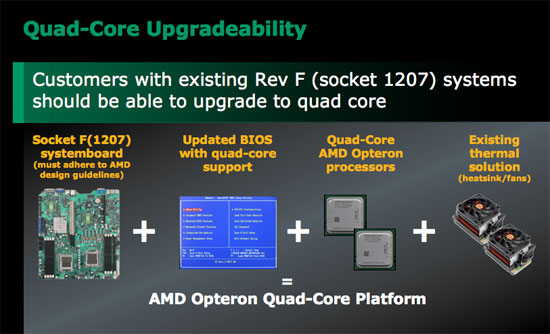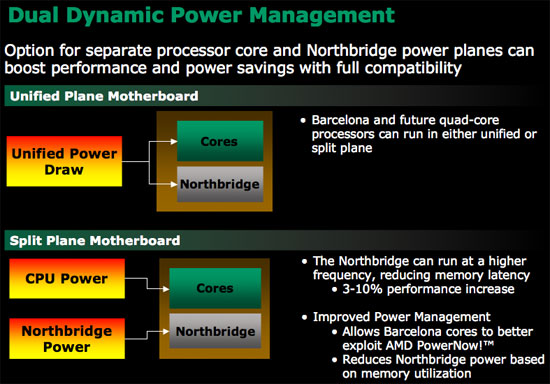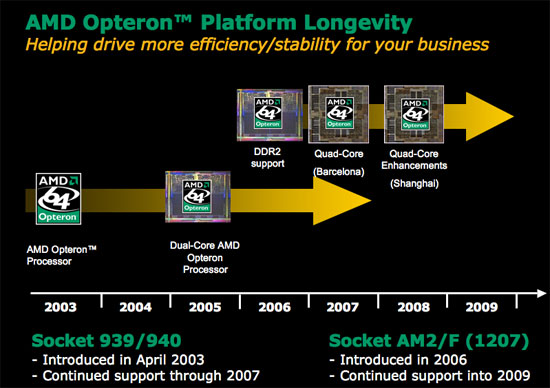New Details on Barcelona Emerge
If you've been following AMD's latest roadmaps then you'll know there are a couple of new sockets on the way. While AMD's next-generation CPUs will work in current Socket-AM2 and Socket-1207 motherboards, a new class of boards will launch with support for Socket-AM2+ and Socket-1207+. Inevitably the question you will ask yourself is: what does the + get you?
The pinout of Socket-AM2 and Socket-AM2+ is identical, and likewise Socket-1207 and 1207+, and thus the same Agena or Barcelona will work in both sockets, which is how AMD is able to guarantee full backwards compatibility with current AM2 and 1207 motherboards. If you do buy a new motherboard that uses either Socket-AM2+ or 1207+, you will get some additional functionality.

Current platforms only support HyperTransport 2.0, while the new + platforms will enable HT3.0 which brings faster link speeds and greater bandwidth. For desktops, a faster HT link won't really change performance, but in multi-socket workstations and servers there will be a benefit.

The more tangible feature is the ability to support split voltage planes. As we mentioned in our preview of AMD's Barcelona architecture, the CPU cores and the Northbridge can operate at different voltages and frequencies. In order to enable this functionality, you need motherboard support, thus if you want the power benefits of having the Northbridge and CPU cores on independent power planes you need an AM2+ or 1207+ motherboard.
It's not all about saving power with split voltage planes, as there's also a performance benefit to going AM2+/1207+. When the Northbridge is placed on its own power plane, the motherboard can actually apply more voltage to it than the CPU cores and run it at a slightly higher frequency on the order of a 200 - 400MHz increase. The Northbridge is an extremely low power part of the CPU die and an increase in voltage/clock frequency results in a minor increase in TDP, but it can drive a disproportionately large increase in performance.
With AM2+/1207+ systems, the Northbridge runs at a higher frequency and thus the memory controller sees slightly lower latencies. The shared L3 cache also operates on the same power plane as the Northbridge, reducing L3 cache latency as well. AMD expects the overall performance advantage by going with AM2+/1207+ to be on the order of 3 - 10% over current motherboards.

While your current motherboards will work with AMD's forthcoming CPUs, you'll get better performance out of upcoming Socket-AM2+ and Socket-1207+ platforms. AMD does plan on supporting both AM2 and 1207 into 2009, so you can expect a continued upgrade path for your AMD platforms well after Agena/Barcelona.
If you've been following AMD's latest roadmaps then you'll know there are a couple of new sockets on the way. While AMD's next-generation CPUs will work in current Socket-AM2 and Socket-1207 motherboards, a new class of boards will launch with support for Socket-AM2+ and Socket-1207+. Inevitably the question you will ask yourself is: what does the + get you?
The pinout of Socket-AM2 and Socket-AM2+ is identical, and likewise Socket-1207 and 1207+, and thus the same Agena or Barcelona will work in both sockets, which is how AMD is able to guarantee full backwards compatibility with current AM2 and 1207 motherboards. If you do buy a new motherboard that uses either Socket-AM2+ or 1207+, you will get some additional functionality.

Current platforms only support HyperTransport 2.0, while the new + platforms will enable HT3.0 which brings faster link speeds and greater bandwidth. For desktops, a faster HT link won't really change performance, but in multi-socket workstations and servers there will be a benefit.

The more tangible feature is the ability to support split voltage planes. As we mentioned in our preview of AMD's Barcelona architecture, the CPU cores and the Northbridge can operate at different voltages and frequencies. In order to enable this functionality, you need motherboard support, thus if you want the power benefits of having the Northbridge and CPU cores on independent power planes you need an AM2+ or 1207+ motherboard.
It's not all about saving power with split voltage planes, as there's also a performance benefit to going AM2+/1207+. When the Northbridge is placed on its own power plane, the motherboard can actually apply more voltage to it than the CPU cores and run it at a slightly higher frequency on the order of a 200 - 400MHz increase. The Northbridge is an extremely low power part of the CPU die and an increase in voltage/clock frequency results in a minor increase in TDP, but it can drive a disproportionately large increase in performance.
With AM2+/1207+ systems, the Northbridge runs at a higher frequency and thus the memory controller sees slightly lower latencies. The shared L3 cache also operates on the same power plane as the Northbridge, reducing L3 cache latency as well. AMD expects the overall performance advantage by going with AM2+/1207+ to be on the order of 3 - 10% over current motherboards.

While your current motherboards will work with AMD's forthcoming CPUs, you'll get better performance out of upcoming Socket-AM2+ and Socket-1207+ platforms. AMD does plan on supporting both AM2 and 1207 into 2009, so you can expect a continued upgrade path for your AMD platforms well after Agena/Barcelona.










55 Comments
View All Comments
TA152H - Friday, May 11, 2007 - link
Actually, I do have an idea on what AMD had to do with it. You don't. If you know anyone from Microsoft, ask about it.Even publicly, AMD admitted that Microsoft co-developed it with them.
By the way, when was the last time you used AMD software? Do you have any idea what you're talking about, or just an angry simpleton?
rADo2 - Friday, May 11, 2007 - link
Oh man, AMD copied, in fact, all Intel patents, due to their "exchange". They copied x86 instruction set, SSE, SSE2, SSE3, and many others. Intel was the first to come up with 64-bit Itanium.And AMD is/was damn expensive, while it had a window of opportunity. My most expensive CPU ever bought was AMD X2 4400+ ;-)
fic2 - Friday, May 11, 2007 - link
What does the 64-bit Itanium have to do with x86. Totally different instruction set.And what would the Intel equivalent to your X2 4400+ have cost you at the time? Or was there even an Intel equivalent.
rADo2 - Friday, May 11, 2007 - link
"What does the 64-bit Itanium have to do with x86" -- Intel had 64-bit CPU way before AMD, a true new platform. AMD came up with primitive AMD64 extension, which was not innovative at all, they just doubled registry and added some more.yyrkoon - Friday, May 11, 2007 - link
You mean - A 'primitive' 64BIT CPU that outpeformed the Intel CPU in just about every 32BIT application out there. This was also one reason why AMD took the lead for a few years . . .fitten - Friday, May 11, 2007 - link
It was actually pretty smart on AMD's part. Intel was trying to lever everyone off of x86 for a variety of reasons. AMD knew that lots of folks didn't like that so they designed x86-64 and marketed it. Of course people would rather be backwards compatible fully, which is why AMD was successful with it and Intel had to copy it to still compete. So... it's AMD's fault we can't get rid of the x86 albatross again ;)TA152H - Friday, May 11, 2007 - link
AMD had no choice but to go the way they did, there was nothing smart about it. They lacked the market power to introduce a new instruction set, as well as the software capability to make it a viable platform.Intel didn't even have the marketing muscle to make it an unqualified success. x86 is bigger than both of them. It's sad.
rADo2 - Friday, May 11, 2007 - link
I bought X2 because I wanted NVIDIA SLI (2x6800, 2x7800, 2x7900, etc.) with dualcore, so Pentium D was not an option (NVIDIA chipsets for Intel are even worse than for AMD, if that is possible).X2 was more expensive than my current quadcore, Q6600, and performed really BAD in all things except games.
I hated that CPU, while paying about $850 (including VAT) for it. For audio and video processing, it was a horrible CPU, worse than my previous P4 Northwood with HT, bought for $100, not to mention unstable NVIDIA nForce4 boards, SATA problems, NVIDIA firewall problems, etc.
I never want to see AMD again. Intel CPU + Intel chipset = pure godness.
yyrkoon - Friday, May 11, 2007 - link
SO, by your logic, just because a product does not meet your 'standard' ( which by the way seem to be based on 'un-logic' ), you would like to see a company, that you do not like, go under, and thus rendering the company that you hold so dearly in your mind, a monopoly.Pray AMD never goes under, because if they do go away, your next system may cost you 5x as much, and may perform 5x worse, and there will be nothing you can do about it.
Cheers
TA152H - Friday, May 11, 2007 - link
Not only that, but HP had more to do with the design than Intel.